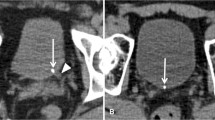Abstract
A consensus is yet to be reached regarding the best strategy for ensuring maximum ureteric delineation during CT urography (CTU). In this study we have compared various CTU protocols to try to establish the best method for ureteric delineation. Saline infusion in the supine position, saline infusion in the prone position, furosemide administration (10 mg, iv) and buscopan administration (20 mg iv) with saline infusion in the prone position were tried in four groups, each having 15 patients who were undergoing CTU. The pelvicalyceal system and ureter were divided into six segments, to each of which an opacification score was assigned (0, unopacified segment; 1, less than 50% opacified segment; 2, 50–99% of the segment opacified; or 3, completely opacified segment) and the results compared. Furosemide administration resulted in complete opacification of 93% of the ureters (28 of 30). In the distal (below the sciatic notch) ureter, the mean score with furosemide was 2.9, while that with saline, supine and prone positioning was 1.87 and 1.83, respectively, and this difference was highly significant (P = 0.0002 and P = 0.0001). It was also significantly higher than the buscopan group (score 2.3, P = 0.002). Also in the lower (the iliac crest to the sciatic notch) and upper (above the iliac crest) ureter, furosemide had significantly higher scores than saline infusion in either position. Saline infusion in the supine and prone positions had very similar scores in all segments that were less than the buscopan group, but this difference was not statistically significant. During CT urography, furosemide administration in low doses is the most effective and convenient technique for ureteric opacification.



Similar content being viewed by others
References
Raptopoulos V, McNamara A (2005) Improved pelvicalyceal visualization with multidetector computed tomography urography; comparison with helical computed tomography. Eur Radiol 15:1834–1840
Fritz GA, Schoellnast H, Deutschmann HA, Quehenberger F, Tillich M (2006) Multiphasic multidetector–row CT(MDCT) in detection and staging of transitional cell carcinomas of the upper urinary tract. Eur Radiol 16(6):1244–1252
Caoili EM, Cohan RH, Korobkin M et al (2002) Urinary tract abnormalities: Initial experiences with multidetector row CT urography. Radiology 222:353–360
Heneghan JP, Kim DH, Leder RA, Delong D, Nelson RC (2001) Compression CT urography: A comparison with IVU in the opacification of the collecting system and ureters. J Comput Assist Tomogr 25:343–347
McNicholas MM, Raptopoulos VD, Schwartz RK et al (1998) Excretory phase CT urography for opacification of the urinary collecting system. AJR Am J Roentgenol 170(5):1261–1267
Caoili EM, Inampudi P, Cohan RH, Ellis JH (2005) Optimization of multi-detector row CT urography: effect of compression, saline administration, and prolongation of acquisition delay. Radiology 235(1):116–123
Chow LC, Sommer GF (2001) Multidetector CT urography with abdominal compression and three-dimensional reconstruction. AJR 177:849–855
Maher MM, Jhaveri K, Lucey BC et al (2000) Does the administration of saline flush during CT urography improve the ureteric distension and opacification? Radiology 221:500
Maher MM, Kalra MK, Rizzo S, Mueller PR, Saini S (2004) Related Articles, Links Multidetector CT urography in imaging of the urinary tract in patients with hematuria. Korean J Radiol 5(1):1–10 Review
Kalra MK, Maher MM, Sahani DV, Blake M, Saini S (2002) Current status of multidetector computed tomography urography in imaging of the urinary tract. Curr Probl Diagn Radiol 31(5):210–221 Review
Nolte-Ernsting CC, Wildberger JE, Borchers H, Schmitz-Rode T, Gunther RW (2001) Multi-slice CT urography after diuretic injection: initial results. Rofo 173(3):176–180
Al-Waili NS, Saloom KY (1998) Intravenous tenoxicam to treat acute renal colic: comparison with buscopan compositum. J Pak Med Assoc 48(12):370–372
Kinnunen J, Saarinen O, Ahovuo J, Edgren J, Laasonen L, Pietila J (1990) Urography with spasmolytics. Rontgenblatter 43(1):20–23
McTavish JD, Jinzaki M, Zou KH, Nawfel RD, Silverman SG (2002) Multi-detector row CT urography: comparison of strategies for depicting the normal urinary collecting system. Radiology 225(3):783–790
Kemper J, Regier M, Begemann PG, Stork A, Adam G, Nolte-Ernsting C (2005) Multislice computed tomography-urography: intraindividual comparison of different preparation techniques for optimized depiction of the upper urinary tract in an animal model. Invest Radiol 40(3):126–133
Author information
Authors and Affiliations
Corresponding author
Rights and permissions
About this article
Cite this article
Sanyal, R., Deshmukh, A., Singh Sheorain, V. et al. CT urography: a comparison of strategies for upper urinary tract opacification. Eur Radiol 17, 1262–1266 (2007). https://doi.org/10.1007/s00330-006-0462-4
Received:
Revised:
Accepted:
Published:
Issue Date:
DOI: https://doi.org/10.1007/s00330-006-0462-4




